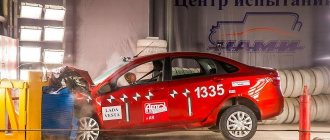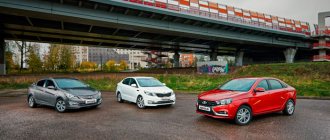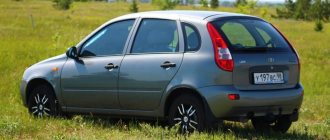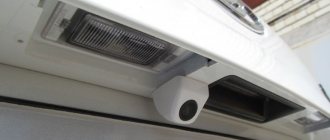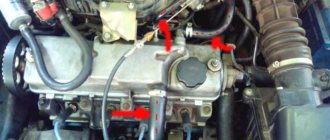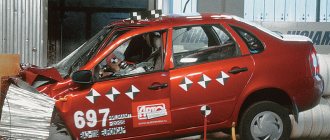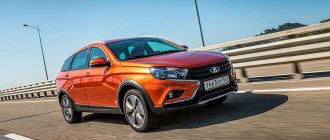Testing methodology
The car in question was destroyed in just one crash test. It was a frontal impact with a 40 percent overlap, and the car itself was accelerated to 64 km/h. Let us clarify once again - here we are talking about equipment 21942-42, equipped with pyrotechnic belt pretensioners. The wheels in this configuration are made of light alloy, which, in turn, could also affect the result.
Station wagon Kalina-2 Lux, photo from the official website
After gaining speed, the station wagon body encounters an obstacle that covers 40% of the space and is located on the driver’s side. This method of testing a car is close to the EuroNCAP methods used for a long time in Europe. What happened as a result is described in the next chapter. In fact, the Lada Kalina car received 3 stars out of 4 possible, which is not so bad. The Granta in the sedan body did not earn much more points, but it was tested using a similar method.
Safety tests of Lada Kalina
The Lada Kalina crash test was carried out several times using a variety of methods, with the first one performed back in 2010. The Autoreview newspaper conducted a world-recognized test of this car using the ARCAP system in 2015.
As a result of comprehensive testing for the degree of operational safety, this model was awarded three stars out of four possible.
It is worth noting that the organizers of the test used a methodology similar to EuroNCAP.
The most expensive version of the Lada, the Lux, was tested, however, the series later showed approximately similar indicators, namely, if Kalina gets into an accident, it can lead to a bruise to the driver’s chest and injuries to his legs, but the passenger will remain unharmed. In addition, a slight degree of deformation of the body and the windshield remained intact were noted.
The second generation of this model also passed the safety test. The crash test of Kalina 2 showed the same results as the first generation of this family. This is due to the fact that this modification of Kalina does not have any fundamental changes, including in the field of safety.
At the same time, you should know that many automobile publications or independent experts conducted their own crash test of Kalina 2. Such a test can be interpreted in different ways, but it does not correspond to recognized methods, so it can only be taken as a recommendation, and not an indication when choosing a given model at the time of buying.
By the way, when studying the results of any tests, it is worth paying attention to what kind of test was carried out. The most common is the frontal impact test, but not all crash organizers can carry out all five tests, since this will require the destruction of at least five copies of the car.
Test result
It can be stated that in Kalina-2 with an automatic transmission, the driver’s shins may suffer. The head of the mannequin, which was in the driver's seat, also received serious mechanical stress. But the passenger, who was on the right side of the driver, was fine after the impact. The following diagram illustrates the words:
One dummy was damaged after a frontal impact
Let us clarify what exactly we were able to observe from the test results:
- The brake pedal offset into the cabin is 141 mm;
- Steering wheel offset – 98 mm;
- Change in the geometry of the doorway on the left (maximum value) – 55 mm.
Now let's look at what happened to the mannequins.
| Type of damage | Implications for the driver | Passenger value |
| Head Injury Index (HIC) | 540 | 340 |
| Bending moment of forces acting on the neck, Nm | 28 Nm | 15 Nm |
| Rib compression, mm | 28 mm | 22 mm |
| Load on the femur, kN | 1.5 kN | 1.2 kN |
| Shin injury rate | 0,72 | 0,3 |
The question remains of how the load on the mannequin’s head changed from second to second. The answer looks like this:
Head load for passenger and driver
The minimum acceleration at which a concussion is recorded is 90-100 g. In general, a trip on Kalina-2 does not threaten anything like this, unless you exceed the speed limit.
Even with concussions, loss of consciousness is rare. However, these words are not a reason for violating the speed limit.
Now let’s compare the obtained figures with the crash test result of another car – the Lada Granta Standard. The rate of damage to the lower leg, for example, turns out to be lower there than indicated in our table. Its value is 0.52 for the driver and 0.41 for the passenger. Perhaps the presence of automatic transmission in LADA cars makes its own adjustments.
Does \"Kalina\" meet safety requirements?
Does Kalina meet safety requirements? What is her real safety in comparison with her classmates?
When Kalina entered the market, Autoreview subjected it to the EuroNCAP crash test. The result was “so-so” - with a frontal impact of 5.6 points out of 16 possible, which is not surprising: the EuroNCAP program was developed for European cars, the requirements for the car are significantly higher than the legally approved standards.
Plus, the first Kalinas were without airbags - the model was not delivered to Europe in this configuration: only “luxuries” with airbags. According to EuroNCAP, independent experts have not tested such a Kalina, and the result should be different. AVTOVAZ engineers told and showed which ones.
Requirements are met
“Kalina” in the “luxury” configuration fully complies with modern European safety standards,” says Alexander Sunenkov, head of the AVTOVAZ crash test laboratory. — Russian safety requirements are met in all vehicle configurations, as we have repeatedly verified by conducting certification tests and inspection tests of vehicles. As for the EuroNCAP program, we, like many other European laboratories, do not have official accreditation from the authorized EuroNCAP body to conduct such tests. But no one forbids reproducing the scenario and counting points. This is, in fact, the result.”
In the laboratory, under a cover, there is a broken red Kalina. Such a sight always causes sadness, and when you see the sagging airbag domes, you just hope that everyone survived. Indeed, the driver and front passenger dummies that took part in the crash test not only remained “alive”, but were not significantly damaged. The fact that all security systems worked accurately is evidenced by prints of special paint from the faces of mannequins on the airbags.
According to the EuroNCAP system, a frontal impact occurs at a speed of 64 km/h. For comparison: UNECE requirements require crash tests to be carried out at a speed of 56 km/h, and Russian standards are limited to 50 km/h, and the impact is not with an overlap into a deformable obstacle, but flat on a concrete cube and without dummies. Therefore, the assessment criteria are different: if, according to UNECE requirements, the design of the car and the injury criteria for dummies are assessed, then according to the requirements of Russian legislation, only the amount of movement of the steering wheel is assessed. Nevertheless, in September 2010, adopted changes in Russian legislation will come into force: in connection with the introduction of a new technical regulation on vehicle safety, the passive safety requirements for new cars launched on the Russian market will become European.
In any case, an accident always happens quickly. The impact time is about 0.5 seconds. But this is enough for Kalina’s security systems to work. Inside the car there is an electronic control unit for the passive safety system, where the accelerometer sensor constantly reads the deceleration of the car and, in the event of a dangerous deceleration, gives a command to operate the restraint systems. First, the pyrotechnic seat belt tensioner is activated, the slack in the belt is taken out and the person is pressed tightly against the back of the seat. This is done so that a suddenly locked belt does not cause a blow to the chest. The airbags then inflate, saving the head and neck. At the peak of “flight” forward, the belt force limiter is activated, loosening the strap so as not to break the bones of the chest from heavy loads... Such devices increase the chances of survival and not adding to the daily traffic police statistics. The Kalina uses an Autoliv security system, specially adapted for the Russian model (similar devices are installed on most foreign cars).
In the "green" zone
So, the catapult accelerated the red Kalina to 64.9 km/h and sent it towards a deformable obstacle with a 40% overlap. The sound of pyrotechnics inflating the pillows and tightening the belts can be clearly heard through the furious grinding of the blow. When the car stopped and the smoke cleared, it became clear that the “safety capsule” remained virtually intact. The driver's door opened without effort. The result of Kalina’s frontal impact is already 10.8 points out of 16 possible. Neither the driver nor the passenger had any dangerous loads recorded. There are no red or brown colors on the diagram of the effects on the mannequins: only green, yellow and orange colors, meaning “excellent”, “good” and “satisfactory” ratings, respectively. It is noteworthy that head and neck protection received the highest ratings. And the driver’s chest, thanks to the seat belt pretensioner, improved the result by an order of magnitude. No contact of the driver's head with the steering wheel was recorded. The peak deceleration was 71g - an excellent result (the "green" zone is up to 72g).
But the EuroNCAP rating (the car was tested according to the 2008 version) is based on the results of two impacts - frontal and side. At a speed of 50 km/h, a special cart hit another Kalina. The car flew off, glass splashed. The result of this impact, which landed at a right angle exactly in the passenger compartment, was 12.8 points out of 16 possible. Special pads on the door pillars protected the head “excellently” (excellent result, “green” zone). The integrity of the interior is maintained thanks to strong cross members running under the front seats and in the instrument panel. Amplifiers in the threshold, B-pillar and roof also played a positive role. The ribs are saved thanks to special cellular inserts in the doors: they not only soften the blow, but also push the person into the cabin, away from the ram. Pelvic protection – “excellent”, lower ribs – “good”, upper ribs – “satisfactory”. There are no dangerous red or brown colors on the diagrams. In principle, both the “luxury” and the cheaper “Kalina” show similar results in a side impact. The difference is in the results of a frontal collision. Based on the sum of the results of two crash tests, a car with airbags and belts with a pre-tensioning and force limiting mechanism scored 23.6 points. Only 0.9 points were missing from four “stars”! But three “stars” (given for a total of 16.5 - 24.4 points) are achieved with a considerable margin.
“We included this rating when designing Kalina,” says Alexander Sunenkov. — This machine was created as an export-oriented model: this level of safety allows it to be supplied to the EU countries. Last year, 1,050 Kalinas were delivered to these markets. We also give Russian car enthusiasts, who are paying more and more attention to safety, the opportunity to purchase the safest car in its price niche - the “luxury” Kalina.
What about competitors?
All Russian crash tests of cars are carried out only in two places: in the laboratory of the Federal State Unitary Enterprise NITSIAMT in Dmitrov and in the AVTOVAZ Scientific and Technical Center in Tolyatti. By the way, the VAZ laboratory is in demand not only among local engineers. Sometimes, in between the safety improvements of Lada cars, crash tests of cars and other companies are carried out here. A distinctive feature of the catapult at AVTOVAZ is that it is located in a completely enclosed room, which allows testing to be carried out year-round. On the huge concrete cube, against which cars crash in the VAZ laboratory, the corporate emblems of all Russian and several foreign brands glitter in scattering. This is how the “catapult” workers “honor the memory” of all the cars wrecked here. Several European brands... and the nameplates of the “Chinese” - the most scandalous participants in crash tests. With varying degrees of success, Geely cars were smashed here, as well as a Cherry Amulet, which folded almost to the trunk...
Frontal impact Geely MK - 6.5 points, BYD F3 - 6 points, Chery Amulet - 1.7 points. Against this background, the “luxury” “Kalina” with its 10.8 points looks decent.
What about the more common and famous competitors?
Renault Sandero, at a price of about 100 thousand more than the Kalina, is only 1.2 points safer in a frontal impact.
Based on the results of a frontal impact, the Chevrolet Lanos in the top configuration scored slightly less points than the Kalina - 10.5.
Fiat Albea earned 8.5 points.
Hyundai Accent - 9.9 points.
As they say, comments are unnecessary.
Chassis and steering
The station wagon's suspension is quite a bit different from that found on the hatchback and sedan - it has more powerful rear springs. But in general, the same high ground clearance - 160 cm, the same successful settings, allowing you to storm curbs and ditches, as well as fairly high and slippery slides, and leave the bumpers in place. Not every imported crossover today can boast of such indicators. In addition, no lateral swing was noticed here, only skillfully combined moderate rigidity and excellent energy intensity.
AvtoVAZ had to work hard with the steering from the Lada Priora, which initially created many problems on the Lada Kalina: in 2007, due to a defect in the steering column, 6.2 thousand cars produced in December 2005 - January 2006 had to be recalled, except In addition, due to a casting defect in the steering gear housing, 171 vehicles, the production of which dated May 24–25, 2006, were recalled. It is impossible to say reliably how the designers subsequently managed to cope with this misfortune, but in our case, the car’s handling did not cause any complaints. The electric booster allows this car to fully unleash the potential of the chassis and engine.
